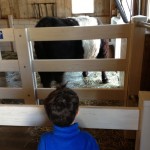Respectful Assertiveness: Teaching Our Children How to Cope and Communicate
I recently attended an extremely informative panel discussion on children’s mental health. Among the many eye opening and critical points made by the panel was the fact that life is filled with challenging social and emotional situations. They suggested that teaching our children how to be deal with such situations can help them significantly in many ways.
We all need coping mechanisms and communication skills. Starting to develop effective ones at early ages goes a long way in being able to access them later in life. Opportunities to exercise thoughtful bravery, intentional kindness in the face of unkindness, respectful assertiveness through uncomfortable interactions, and fidelity of character in various disagreeable circumstances are invaluable to our children’s path toward effective coping and authentic happiness.
It’s not easy to watch our children sad or hurting. When I feel compelled to run the rescue of the kids that I serve I have to remind myself that independence is the goal. The fact is, I’m not always around when they need me. In some situations they simply have to be able to take care of themselves. Of course as parents and educators we need to be cognizant of appropriate developmental capacity and the release of suitable levels of responsibility for independence, but still, I would suggest that we are not doing our children any favors when we run to their rescue.
A few days ago a fifth grader came into my office with a complaint about one of his peers. Apparently the child had been calling him names. He wanted me to make it stop, and I wanted to. But more importantly, I wanted to help him develop his capacity to make it stop on his own. We had a great conversation about his concerns and the potential for respectful assertiveness in this situation. I told him that sometimes all it takes is letting someone know how you feel and what you expect.
I coached him on how to do that in a strong but compassionate way. I worked to help him understand that oftentimes when a person chooses to be unkind he’s actually unhappy. I guided him through possibilities for expressing his concerns and ongoing needs while also being sensitive to the potential sadness that the name caller might be feeling. I reminded him that I’m always here if it doesn’t work. I didn’t want to make the mistake of letting him feel that he was on his own or that he didn’t have options, I just wanted him to know that I believe in effective communication and that I believe in his ability to use it. I also made clear that I believe in his capacity to cope with this unfortunate challenge.
Today the same student came rushing into my office with a huge smile on his face. Turns out it seemed to work this time. We all know that it doesn’t work every time, but I truly believe that our children do benefit from the development of tools and strategies that they can employ in challenging social emotional situations, highlighted opportunities to use those tools and strategies along their paths to adulthood, and the clear articulation of our faith in their strength and determination for peaceful resolutions and mutual happiness.
We must be giving our children support and permission to sort through the many social and emotional challenges that come along with being alive in this world. We must teach them how to work with one another in good times and in bad, because we know all to well that they will continue to experience both throughout their lives. Like it or not, we also know that they will very soon be required to do so without our guidance. Like our parents knew and theirs before them, we won’t always be around to catch our children when they fall. It’s not easy, but I would suggest that it’s critically important to focus intently on the development of coping and communication skills in our children, even and especially when we’d rather just protect them from the struggles that often accompany that development.
Live. Learn. Lead.
Dream Big. Work Hard. Be Well.








